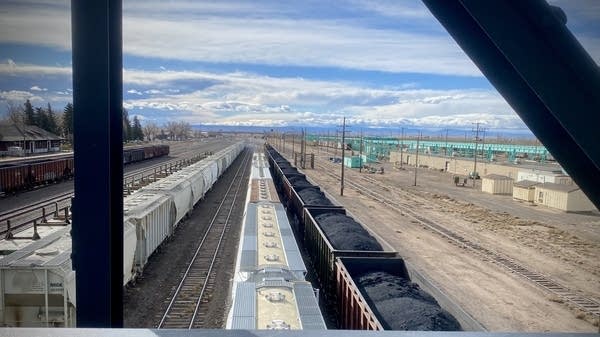Greening your 401(k) is easier said than done
What happens when I try to figure out how to make my retirement account less horrible for the climate.

I want to make my retirement account more environmentally friendly. Thing is, this goal is in the same camp for me as learning to sew my own clothes, play the cello or speak French conversationally — I love it in concept, but the reality of actually accomplishing those goals is beyond daunting.
The latest season of Marketplace’s “How We Survive” podcast examines the rise and fall of ESG investing, or investments that consider environmental, social and governance factors. The last episode focuses on reducing your carbon footprint by examining the investments in your retirement portfolio.
“It turns out that moving your investments to a climate-friendly investment option is the single most impactful thing that the average American can do for climate change,” Alex Wright-Gladstein told Marketplace’s Amy Scott. Wright-Gladstein is the founder and CEO of Sphere, a company focused on climate-friendly investing.
That line got me thinking about my own retirement account. I am by no means rich — no one goes into public radio to become a millionaire — but my retirement savings are the single largest sum of money I’ve invested at the ripe old age of 26. So I want to feel good (and secure) about it.
So I went out on a personal quest: To more closely examine what investments my 403(b) — the nonprofit version of a 401(k) — held, interrogate the environmental impact of those investments and see how easy it would be to change them.
Getting under the hood
One of the trickiest parts about trying to green your retirement portfolio is first learning all of the investments in it.
Many retirement accounts are target-date funds, a mix of investments set to get more conservative in risk as you near a goal retirement year — in my case, 2065. (Wow, it’s depressing to read that written out.)
I have a target-date fund hosted with Vanguard, symbol VLXVX. Checking out the specifics of what exactly is in VLXVX, is … tricky. The online investment profile displays sectors my portfolio includes. Mine is heavily weighted in technology, financial services, industries, consumer cyclical (totally know what that means), the list goes on and on. Specific companies and their impact on the environment? Those are elusive.
So, I decided to ask someone who did all this hard work before me: journalist Alison Takemura. She wrote an article a few years back about divesting her own retirement account from fossil fuels.
“You're starting from this place of uncertainty,” she said. “You have to connect all those dots. If it's a mutual fund, is there information about what stocks are held in that mutual fund? If it's a target-date fund — which a lot of retirement funds or retirement programs offered by employer organizations will funnel you into — these target-date funds don't give any indication.”
Figuring out what’s under the hood
Here’s the thing: Figuring out what your various holdings are in your retirement accounts is not easy. The portfolio composition of my retirement account is other funds. I investigated those funds further and could see their stock holdings. My retirement fund invests in VSMPX, or the Vanguard Total Stock Market Index Fund Institutional Plus Shares. And that includes investments in some 3,562 different companies.
If it seemed like acquiring a conversational capacity for French was a toughie, imagine how daunting investigating the environmental impacts of each of the more than 3,500 companies that a portion of my retirement account included seems. I simply do not have that many hours to spare.
Where to turn? FossilFreeFunds.org. From there, you can enter the fund name or symbol and view a grade based on various holdings on their investments in fossil fuels. My target date fund, VLXVX? It got a D. If I got that grade in high school, I probably would have had a minor panic attack.
“[FossilFreeFunds.org] really makes it transparent what different mutual funds hold, and they update that data on a quarterly basis, and then they grade it,” Takemura explained.
My fund invests close to $800 million in fossil fuel across major companies like ExxonMobil, Shell and Chevron. Which … doesn’t make me feel great.
Here’s the thing: I want to have kids someday. And I want them to inherit an Earth that’s habitable. But … I also want to be able to retire someday. And energy companies make money — that’s why people invest in them.
So are these two goals incongruent? That’s more of a divisive question.
Should I divest from fossil fuel companies?
I’ve considered divesting my retirement portfolio from fossil fuel companies. But when I brought up divestment to Witold Henisz, vice dean and faculty director of the ESG Initiative at Wharton, he offered a different perspective.
“It's really important to think about the implications of a divestment strategy, as opposed to what's called an ‘engagement strategy.’ And it might make you feel good to divest, it might make you feel like you've done something really concrete. But another word for ‘divestment’ is ‘disengagement,’” he said. “Disengagement is a less rosy-sounding, less positive-sounding term, but it's really what you're doing when you divest.”
If the folks who care about the energy transition divested from companies that invested in fossil fuel production, Henisz argued, who would be left holding those stocks or buying them up? How do you know those investors won’t push the company to invest more in fossil fuels?
“I'm certainly more on the camp of active ownership and exhibiting voice and trying to influence these companies from within,” Henisz said. He added that investors should look into the specific initiatives and investments that energy companies are putting forth.
“If we're thinking about hydrogen, if we're thinking about carbon capture, if we're thinking about fusion, it's reasonable to think that some of those innovations are going to come out of the fossil fuel companies,” he said.
An alternative view and what divesting actually looks like
Alison Takemura takes the opposite view of Henisz. She divested from fossil fuel funds using what’s called a tethered brokerage account. Essentially, she sold the assets in her retirement account, then opted to invest them in a fund that more closely aligned with her values.
That website, FossilFreeFunds.org? It shows you funds that receive an A grade in terms of fossil fuel investment. You can also parse how well each fund does in relation to other morally dubious sectors, like private prisons or tobacco and e-cigarette manufacturing.
Another route folks can take? Take advice from friend of Marketplace Molly Wood: Contact your company’s benefits manager and encourage them to offer climate-friendly retirement funds.
For Takemura — like for me as I’ve started this process — taking a more active role in her finances seemed daunting. Initially, she made calls to her financial services provider: Did this make sense? If I do this, will it be OK?
“I was secure in knowing that the money wasn't going to disappear,” Takemura said. After moving the retirement funds, “I could use the money in the brokerage account to get shares of a different fund that I actually aligned with.”
Another option that Takemura explored was using a financial adviser who could help her align with her investing — and ethical — goals. The ones offered through her company’s plans and others she found with pre-consultation calls just didn’t quite fit the bill. So she decided to take matters into her own hands using a tethered brokerage account.
She didn’t switch everything over all at once — she started with new contributions. That felt more manageable. Then, she eventually sold and moved her older retirement funds. Using the rankings on FossilFreeFunds.org, she looked at funds that had better grades on fossil fuel investment, as well as in the other categories she cares about.
Many of the asset managers who receive top grades from an environmental perspective are smaller asset managers, relative to the big-time players like Fidelity or Vanguard. And that can be a little scary.
But it’s really the switching of funds that feels like the scariest part. You can view past performances of specific funds — like any investment, past performance does not guarantee future results — and weigh that against your values. That’s what Takemura did, and so far, she’s content with how her retirement fund has grown.
“My investments have generally tracked the market,” Takemura said while cautioning that she is not a financial advisor. “It's grown as the market has seen kind of unprecedented growth. I don’t think [my investments] have outperformed the market, but I don’t think they’ve done that differently either.”
Reflections and investments
Transparency is important to me. I’ll be honest: I haven’t switched any future or current investments — yet. I want to. But frankly, it scares me.
“I think you should always be attuned to the time horizon in which you need you know to pull out your capital and the time horizon in which you're more confident in an investment,” said Wharton’s Henisz. If you’re investing in companies that prioritize the green energy transition, “you are taking on certain risks, and those risks may not pay off in the short term.”
I also recognize that the people who manage retirement funds probably know more about the market than I do. It’s nice to have faith in them and not take on more work.
But, at the same time, I care about the future, and I’d like to know that where my money goes is not doing active harm — to the planet, to workers around the globe, to the health of the consumers who buy products being made.
For Takemura, who has transitioned several retirement accounts resulting from multiple jobs, it’s gotten easier. The fear that comes with touching this large sum of money gets easier to swallow. And the weight of knowing that her investments aren’t working toward a bleaker climate future is something that she takes solace in.
“It's a personal action that you can take in your own life, and it's just been incredibly rewarding,” she said. “I think people try to optimize on just one dimension. They're trying to optimize for profit, for returns. But that's not all there is to life. Life is about joy and freedom and awe and nature and safety for you and your loved ones and so much more — and climate change threatens all those things.”
Again, to be clear: I am not a financial adviser. And how I’m thinking about my own investments may differ from someone looking to retire in the next five or 10 years. I’ve still got decades to add to my resume before I retire (if I’m ever able to).
So I haven’t adjusted the investments in my retirement account or wholly divested yet. But, on my ever-looming list of to-dos, it seems a little less daunting now that I’ve learned my options. Either way, it seems more doable than learning conversational French.













